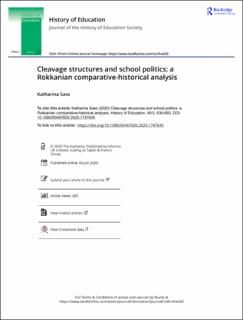Cleavage structures and school politics: a Rokkanian comparative-historical analysis
Journal article, Peer reviewed
Published version

View/
Date
2020Metadata
Show full item recordCollections
- Department of Sociology [429]
- Registrations from Cristin [9791]
Original version
History of Education. 2020, 49 (5), 636-660. https://doi.org/10.1080/0046760X.2020.1747645Abstract
This paper explores comparatively and historically why Nordic andContinental welfare and education regimes differ in the degree ofcomprehensiveness of their primary and lower secondary schoolsystems. It analyses how school reforms, reform attempts andcoalitions in the post-war decades were shaped by different clea-vage structures in Norway and the German federal state of NorthRhine-Westphalia. While the class cleavage was most dominant inschool politics in both cases, rural–urban, centre–periphery, state–church and communist–socialist cleavages shaped party systems,political alliances and outcomes decisively. In particular, the ruralpopulation was integrated into different cross-interest coalitions:in Norway, its political representatives consented to social demo-cratic comprehensive school reforms, while in Germany, theyopposed such reforms. This was related to cross-cutting conflictsconcerning centralisation and language in the Norwegian caseand regarding religion, centralisation and (anti-)communism inthe German case.
